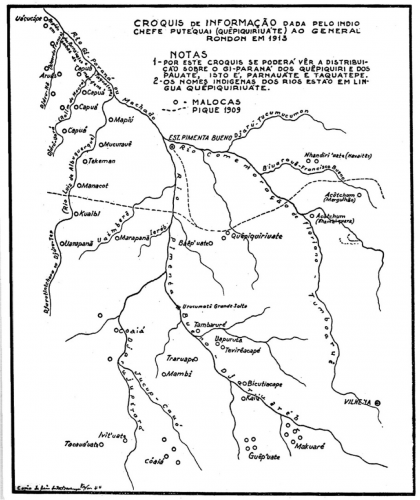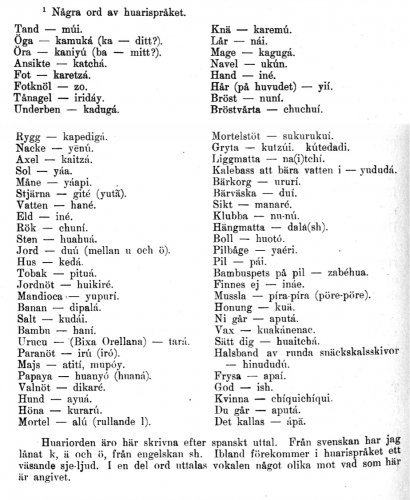Anthropologists have identified several cultural complexes in Rondônia. Lévi-Strauss (1948) identified the cultures on the right side (going downriver) of the Guaporé River as belonging to the ‘Guaporé culture area’, divided into a western Chapacura sub-area and an eastern Tupi sub-area. This classification was superseded by the research of Denise Maldi, who has conducted ethnohistorical research in western Rondônia and Mato Grosso since the early 1980s. Maldi (1991) defines a part of Lévi-Strauss’ Tupi area as the ‘Marico cultural complex of Rondônia’. The Marico cultural complex includes not only cultures of Tupi-speaking peoples, but also of speakers of Jabutian (Macro-Jê family) languages as well as the isolate languages, and is characterized by a combination of the following traits:
- semi-nomadic swidden agriculture combined with hunting and gathering
- relatively small egalitarian societies
- territorial subgroups that often bear animal names
- territorial subgroups that may form alliances despite linguistic differences
- spiritual culture involving shamanism and hallucinogenic substances
- material culture characterized by the marico, a crochet bag made of the fibres of specific palmtree leaves
- consumption of chicha, a fermented alcoholic brew mainly based on maize, yam, manioc, patauá seeds (of the Oenocarpus bataua palmtree) or banana, mashed, fermented and strained in a specific way
In spite of the great linguistic diversity on the right side of the Guapore River, these shared cultural traits point to a long history of interethnic contacts and intermarriage between neighbouring groups. Interethnic contact was not limited to specific river basins but also took place over land between groups on different headwaters. Although contributing to different river basins, the headwaters of the Branco, Mekens, Tanarú and São Pedro Rivers all start relatively close to each other on the same section of the Parecis plains. It is likely that certain linguistic similarities that found among different languages throughout parts of the region can be explained by many centuries of interethnic contacts rather than by genetic linguistic relations (Crevels & van der Voort 2008).
Aikanã:
The Aikanã are encountered in the literature by different names: Aikanã, Massaká, Kassupá, Huarí, Corumbiara, Mondé, Tubarão, and there are still other names. However, the autodenomination is Aikanã. The Aikanã were mentioned for the first time in 1913 by the name Uapuruta (recognised by the Aikanã as Waikurutá), on a hand-drawn map made by the Comissão Rondon during a visit to the Kepkiriwat Indians (cf. Rondon & Faria 1948). Aikanã informants today confirm that the Waikurutá represented one of the Aikanã subgroups. Apparently, Rondon considered them, like the Charamein (Salamãi), to be a subgroup of the Kepkiriwat, probably because they maintained friendly relationships with each other and because their cultures were similar.
The first clear eyewitness account of the Aikanã people, with descriptions, photographs and a sample of their language, was given in 1914, by the Swedish ethnographer baron Erland Nordenskiöld. In his 1915 book Forskningar och Äventyr i Sydamerika, he describes his encounter with the ‘Huarí’ people on the headwaters of the Rio Corumbiara. The ethnonym Huarí was given to them by the (now extinct) Pauserna people. The personal names and the 83 ‘Huarí’ words that were registered in Nordenskiöld’s manuscripts are practically identical with those of the present-day Aikanã.
The Aikanã had probably already been in contact with Westerners before the short visit of Nordenskiöld, but the big cultural changes only came a little later, with the entry of the rubber entrepreneur Américo Casara (see Albert 1964), who employed them in the extraction of rubber, ipecac and other native products of the region. There are many indications that the Aikanã got along relatively well with Westerners. They provided valuable services to the expeditions of the Comissão Rondon in the first decade of the 20th century, the Urucumacuan Expedition of the 1940s, the building of the BR-364 highway in the 1960s, and other government initiatives until present times. Currently they are participating in FUNAI expeditions to protect isolated groups in the Massaco, Omeré and Tanarú regions.
Since 1973, the majority of the Aikanã have been living on the reserve Terra Indígena Tubarão-Latundê (demarcated in 1983), close to the town Chupinguaia. There they continued to extract rubber until 1997 and subsisted by hunting and swidden agriculture. In 1975 they contacted an isolated family of Aikanã, led by Capitão Arui Uhune’i, who had split off in the late 1940s and lived in a remote part of the reserve. With the re-established relationships with this family, knowledge of traditional shamanic healing was reintroduced into the community, as well as new marriage candidates. In 1976, the Aikanã contacted a previously unknown group of Northern Nambikwara, the Latundê, in the remote savannah-like eastern interior of the reserve. Nowadays the Aikanã live on this reserve together with the remaining representatives of the Kwaza people, one semi-speaker of Salamãi and with the last of the Latundê. Today, speakers of Aikanã also live in the Terra Indígena Kwazá do Rio São Pedro, in the nearby towns like Chupinguaia and Vilhena, and in the capital Porto Velho.
In 2012 a group of Kassupá and Salamãi managed to secure a small indigenous area about five kilometers outside of Porto Velho, which previously belonged to the Ministry of Agriculture. The members of this group are descendants of Aikanã and Salamãi who were transported in the 1940s by the SPI (Indian Protection Service) to the indigenous post Ricardo Franco on the Guaporé River. From there many became further dispersed during the subsequent decades and in the late 1960s a group of them was resettled in the barracks at the Ministry of Agriculture outside Porto Velho. The Aikanã language is still spoken there by one elderly woman. The Salamãi language is still remembered by an elderly woman who lives in the city of Porto Velho. Since the mid-1990s this group of Kassupá and Salamãi has been trying to reclaim its ethnic identity.
One of the negative aspects of the (direct or indirect) contact with Westerners was the decimation of the Aikanã, especially through contagious diseases against which they had no resistance. Furthermore, the loss of their most fertile lands, and the forced acculturation by representatives of Western culture (lumbermen, missionaries, government officials etc.) resulted in a decrease in transmission of traditional indigenous culture. While all generations still learn the language, but traditional cultural knowledge is disappearing under Western ecological, cultural and religious pressure.
Kwaza:
The Kwaza were usually encountered in the literature as the Koaiá. Presently, the autodenomination Kwaza is used increasingly by Indians and Westerners alike. The Kwaza were mentioned for the first time on the 1913 manuscript map of the Comissão Rondon as Coaiás. The Kepkiriwat leader from whom the information was obtained located them on the São Pedro and Taboca Rivers. According to the Nambikwara they were cannibals and they, as well as other groups of the region, feared them.
The first albeit fragmentary account of the Kwaza people, with photographs and a sample of their language, resulted from the encounter of Claude Lévi-Strauss and Luiz de Castro Faria with the ‘Mondé’ (who turned out to be Salamãi) in 1938. Apparently, several Kwaza individuals either lived among the Salamãi or were on a visit. Neither Lévi-Strauss nor de Castro Faria identified them as Kwaza, but Lévi-Strauss’ word list, taken from a boy originating from the São Pedro River, leaves no doubt about the language. Furthermore, it is possible to recognize the Kwaza woman Makytxa in some of the photographs taken by de Castro Faria.
At the time of Lévi-Strauss, the Kwaza were probably already decimated, both by exogenous diseases and, according to the Aikanã, by warfare. Even though their language shows many likely traits of contact with other languages and their culture clearly belongs to the Marico cultural complex, they apparently did not maintain very friendly relationships with other groups during the 20th century. In the 1960s they formed only one or two families living among the Aikanã at the mouth of the Tanarú River, and in 1973, they moved together with the Aikanã to the reserve Terra Indígena Tubarão-Latundê. In 2000 a small reserve was demarcated for the Kwaza on their traditional lands, the Terra Indígena Kwazá do Rio São Pedro. The sparse early documents in combination with modern documentation and analysis of their language contributed to the judicial evidence supporting the land claim (van der Voort 1997, 2007a, 2008).
The last ethnic Kwaza who was born in traditional times died in April 2008. Unfortunately he did not pass on much of his traditional cultural knowledge and certain information can only be obtained from elderly Aikanã.
References:
Albert, Claude P. 1964. Americo Casara: Conquistador pacifique de l’Amazonie. Lettre d’Amazonie.
Anonymous. 1916 [2003]. Missão Rondon: Apontamentos sobre os trabalhos realizados pela Commissão de Linhas Telegraphicas Estrategicas de Matto-Grosso ao Amazonas, sob a direcção do coronel de engenharia Cândido Mariano da Silva Rondon, de 1907 a 1915. Publicados em artigos no Jornal do Comércio do Rio de Janeiro em 1915. Rio de Janeiro: Typ . do Jornal do Commercio, de Rodrigues & C. [Re-edition in modernised spelling 2003. Edições do Senado Federal 8. Brasília: Senado Federal, Secretaria Especial de Editoração e Publicação. Also at http://www2.senado.gov.br/bdsf/item/id/1077].
de Castro Faria, Luiz. 2001. Um outro olhar: Diário da expedição à Serra do Norte. Rio de Janeiro: Ouro sobre Azul.
Lévi-Strauss, Claude. 1948. Tribes of the right bank of the Guaporé river. Handbook of South American Indians 3, Julian H. Steward (ed.), 370–379. Washington DC: Smithsonian Institution.
———. 1955. Tristes tropiques. Paris: Librairie Plon.
———. 1994. Saudades do Brasil [Longing for Brazil]. São Paulo: Companhia das Letras.
———. 1995 [1938]. Untitled. Manuscript and letter of 25-12-95, 3 pp. Paris.
Loukotka, Čestmír. 1963. Documents et vocabulaires inédites de langues et de dialectes sud-américains, Journal de la Société des Américanistes, Nouvelle série, tome LII, pp. 7-60.
Nordenskiöld, Erland. 1915. Forskningar och Äventyr i Sydamerika, Stockholm: Albert Bonniers Förlag.
Reesink, Edwin B. 2010. Allegories of wildness: Three Nambikwara ethnohistories of sociocultural and linguistic change and continuity. Amsterdam: Rozenberg Publishers.
Rondon, Cândido Mariano da Silva. 1916. Conferencias realizadas nos dias 5, 7 e 9 de Outubro de 1915 pelo Sr. Coronel Cândido Mariano da Silva Rondon, no Theatro Phenix do Rio de Janeiro sobre trabalhos da Expedição Roosevelt e da Commissão Telegráfica. Rio de Janeiro: Typ. Leuzinger.
Rondon, Cândido Mariano da Silva & João Barbosa de Faria. 1948. Glossário Geral das tribos silvícolas de Mato Grosso e outras da Amazônia e do Norte do Brasil. Tomo I, Publicação no. 76 da Comissão Rondon, Anexo no 5 – Etnografia. Rio de Janeiro: Ministério da Agricultura, Conselho Nacional de Proteção aos Índios.
van der Voort, Hein. 2004. A grammar of Kwaza. Berlin / New York: Mouton de Gruyter.
———. 2007a. Theoretical and social implications of language documentation and description on the eve of destruction in Rondônia. Peter Austin, Oliver Bond & David Nathan (eds), Language Documentation & Linguistic Theory: 75 years of linguistics at SOAS, 5 years of Endangered Languages Project, London: School of Oriental and African Studies, University of London. p. 251-259. <http://www.hrelp.org/publications/ldlt/papers/ldltproceedings.html>




